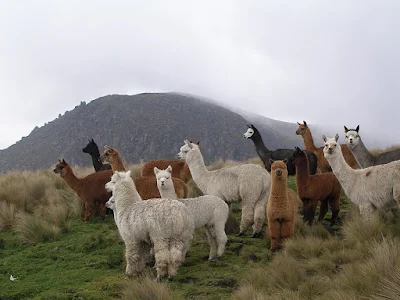20+ Interesting Facts About Alpacas
- Alpacas are closely related to other South American camelid animals. These include llamas, vicuna (a wild form of alpaca), and guanaco (a wild cousin of the llama).
- Alpacas are native to Peru. They are also present at high altitudes in other South American countries: Ecuador, Bolivia, and Chile.
- Alpacas have been exported to different parts of the world thanks to their numerous benefits. Today, they are present in all continents except Antarctica.
- As compared to 30 teeth of female alpacas, male alpacas have 32 teeth. These two extra razor-sharp teeth are known as fighting teeth due to their usage during a fight.
- Male alpacas and llamas can sometimes become aggressive towards their masters. It is due to a syndrome (ABS or Aberrant Behavior Syndrome) that usually develops in bottle-fed male alpacas that lose the company of their mothers in childhood.
- Alpacas are helpful in therapy for the treatment of trauma and mental health issues. This treatment is effective for people of all ages. (Source)
- Alpacas are specifically bred for their sheep’s wool-like fiber. This fiber is used for manufacturing sweaters, coats, socks, blankets, hats, and textile materials.
- Alpaca fiber is known as ‘super fiber’ due to several qualities. It is breathable, less allergic than other
fibers, windproof, flame-resistant, and stain-resistant.

Alpaca's fiber is available in several natural colors - Another importance of alpaca fiber is its availability in multiple natural colors. There are around 25 colors for alpaca fibers. (Source)
- Alpaca wool is durable and resistant. It is one of the strongest mammal fibers in the world. It is suitable for materials like ski ware, hiking wear, and outdoor gear. (Source)
- A unique behavior of alpaca is spitting. Its spit contains saliva and acidic stomach content. An alpaca can spit up to 10 feet away. Females usually spit when not interested in a male alpaca. Males spit as a defensive or aggressive technique against other animals.
- Based on their fiber, alpacas are divided into two breeds Huacaya and Suri. Around 90% of alpacas belong to the Huacaya breed, thanks to their thick fleece that helps them survive the higher altitude of the Andes.
- Suri alpacas are suitable for lower altitude areas. They have thin fleece that can’t protect them in severe weather conditions of higher altitudes.
- Apart
from providing precious fiber, another vital service by alpacas is
livestock protection. Their alertness, excellent hearing, and sharp eyesight for a distance of over 1
km make them one of the best protectors for sheep, hens, ducks, etc.
They can protect the herd from dogs and foxes by chasing, spitting, kicking, and
making high-pitched noises. (Source)
- Alpacas are also very tidy animals. They designate a single place for defecation, used as a communal dung pile. Alpacas don’t graze in this area, which protects them from spreading internal parasites. The communal dung pile is easier to pick and use as a natural fertilizer.
- Along with spitting and several other body gestures, alpacas express their feelings also through several sounds. These include snorting (during the invasion of other alpaca), grumbling (for warning), screeching (for terrifying opponent), clucking (friendly sound), and others.
- The grass-mud horse, a fictional animal similar to alpacas, symbolizes anti-censorship in China. This animal is used on the internet to express sentiments against the Chinese government and the Communist Party. (Source)
- Alpacas are herbivores, and their favorite food is grass. They also eat leaves, stems, and bark. Unlike other grazing animals, alpacas’ diet is moderate, and they eat only 1.5% of their body weight daily.
- Alpacas are very social animals and can’t live alone. There should be at least three alpacas together at a time. A single alpaca will soon get sick and die.
- Alpaca babies are usually born between 7 am and 3 pm. Alpacas born during the evening or night need special care to survive.
- After vacuna, alpacas are the second smallest species of camelids. Their length (head and body) ranges from 47 to 85 inches.
- Unlike many other members of the camelid family, alpacas have a small single fat pad on each digit. Their narrow footpad assists them in inhabiting several environments, including arid mountains, temperate forests, and savannahs.



Comments
Post a Comment